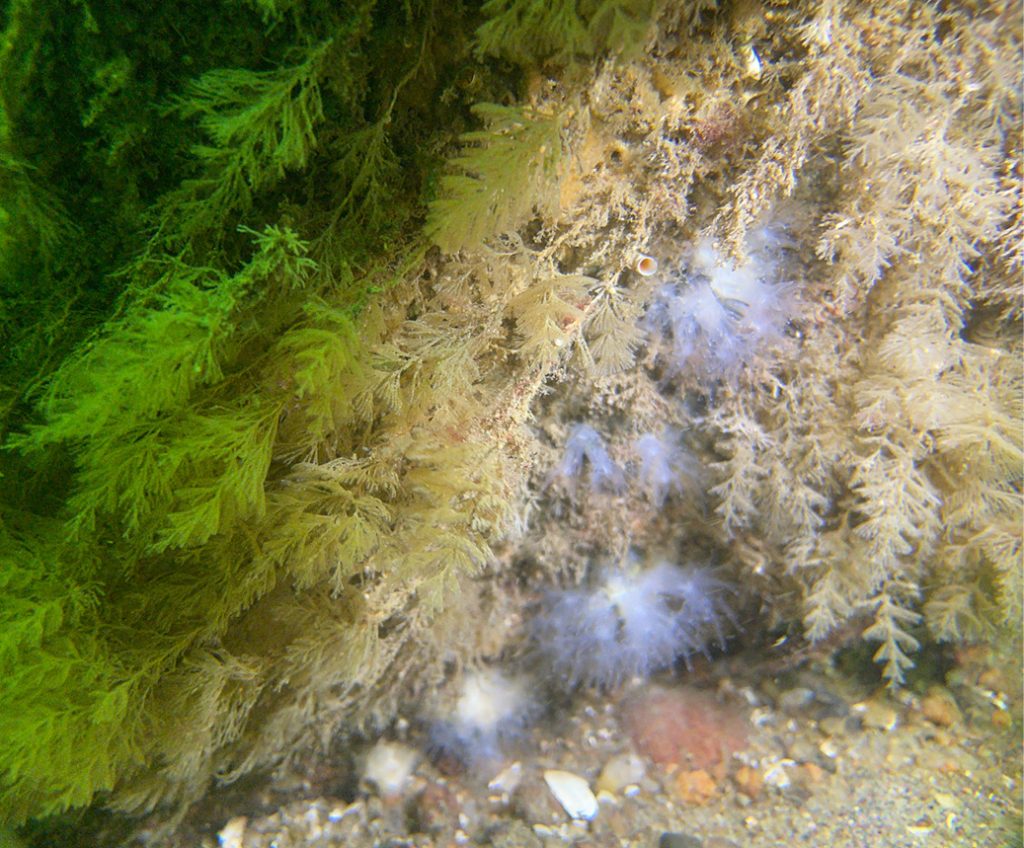By Louise Harrison
If names like moss animal and dog whelk sound counterintuitive, or if blood ark, skeleton shrimp, and spider crab seem mildly disturbing, would you be surprised they belong to creatures found around Plum Island, New York, home of a federal animal disease laboratory? Would you be relieved to know they’re perfectly normal marine animals in a healthy ecosystem in Eastern Long Island Sound?
We know these and many other species live in Plum Island’s underwater regions because scientific divers have been conducting biodiversity surveys there, in 2019 and again this year, for the New York Natural Heritage Program (NYNHP), part of the State University of New York’s Research Foundation. Save the Sound sponsored the Plum Island inquiries through private donors, and InnerSpace Scientific Divers provided scientists who specialize in these kinds of biological inventories.
This past August, four scientific divers expanded on the preliminary 2019 studies. They conducted five days of underwater surveys around Plum Island, documenting marine life at 78 sampling sites (“quadrats,” or frames, each a square meter), laid out in a pattern along seven lines (“transects”) perpendicular to the shoreline around the island. Divers noted every species within the quadrats at depths of 30 feet, 20 feet, and 10 feet, determined how much space each species occupied, and collected samples of species that couldn’t be immediately identified. They did this otherwise standard biological inventory work underwater, in swift currents, where it’s never been done before.
What did the scientists find? “Incredibly diverse habitat.” “Pristine.” “No evidence of human disturbance.”—these were among their first remarks upon surfacing. Since then, the team has been going through their data sheets (on waterproof paper, filled out underwater at each sample site), identifying species, and poring over extensive photographic and video imagery. They’ll report their findings—lists of species and detailed descriptions of underwater communities—in March of 2022, but what we know now is they are excited about high biodiversity, colorful organisms covering every hard surface, much life burrowing under swiftly shifting sands, and a variety of habitats. Ghostly white, northern star coral polyps filter the water column for sustenance alongside sea anemones, sponges, marine worms, and those “moss animals.”

Northern star coral (showing white polyps) and bryozoans attached to base of submerged boulder at Plum Island, New York. © InnerSpace Scientific Diving
Otherwise known as bryozoans, moss animals abound on the giant boulders left behind by glaciation. They’re stalked, permanently attached, and are quite beautiful. Long strands of sugar kelp extend horizontally in swiftly moving, highly oxygenated water, where unanchored sea life moves by a diver’s mask so quickly it barely can be accounted for without a video camera.
Fish swim around the completely inhabited boulders, as if cruising reefs. Crabs cruise the bottomlands solitarily or in army fashion. Scientists observe harbor and gray seals and receive inquisitive stares in return. Divers’ respiratory bubbles are followed by bubbling exclamations of ecologist-delight upon examining trays of live specimens aboard the dive vessel or in the makeshift motel laboratory at night. Team members recall high spirits, hard work, difficult working conditions, day-to-day flexibility mandated by weather changes, and amazing discoveries. The survey will be a major step toward protecting the island and its resources, according to Matthew Schlesinger, Chief Zoologist with NYNHP, and will help frame future studies there.
The 2021 Plum Island dives were a study in cooperation and generosity, too. The marine program at Cornell Cooperative Extension of Suffolk County studied eelgrass beds while InnerSpace conducted the transect work; both teams shared data. Save the Sound’s own Soundkeeper Bill Lucey captained one dive boat; volunteer Paul Ahern captained his own boat to provide the other. Paul hired Northeast Diving Services to capture footage of the scientists’ work, which video producer Ilene Merenstein plans to use in a documentary. Supporters contributed funds, time, goods, services, discounts, space, and good will for this one-of-a-kind study. All understand that the result will further prove why Plum Island should be preserved in perpetuity for nature, for people, and in celebration of our richly intertwined cultural and natural heritage.
For more information, visit preserveplumisland.org or
contact Louise Harrison at Save the Sound at
lharrison@savethesound.org. The initial 2019 dive report
may be downloaded from nynhp.org/documents/12/PlumIslandMarine_20Apr2020.pdf. ■
Louise Harrison is Save the Sound’s New York Natural Areas Coordinator. She helped organize the 2021 Plum Island marine biodiversity survey and was aboard vessels attending the dives.



